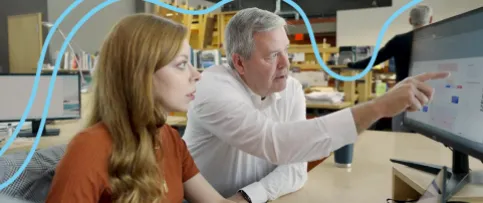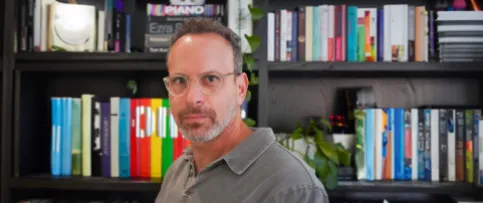Recently licensed architect Zachary Stoltenberg shares his tips for getting licensed, studying, and giving back to the profession.
Why did you want to become an architect?
I knew in seventh grade I was going to be an architect. I drove most of my teachers crazy once I learned how to letter in drafting class because I used it for everything. When I was 10, my parents added onto our house, and my mom and dad did much of the work themselves; my dad got me involved with everything he could. By high school I had sweat pipes, framed walls, laid tile, you name it. My fascination for construction eventually grew into an absolute love for design, creating spaces, and problem solving.
How long did it take you to complete your experience and exams?
When I graduated in 2009, I moved into one of the worst job markets in a decade. Thankfully my wife had a stable career, so in 2010 I was able to start my own company doing small residential design while enjoying raising my kids as a stay-at-home dad. I went back to a full-time position in an office once my kids started school in 2014, and then I really started to focus on completing the Architectural Experience Program™ (AXP™) and Architect Registration Examination® (ARE®).
It took me a little over seven years in total to complete my experience, but a majority of my experience was completed in the last two and a half years. It took me just over two years to complete my exams, with a six-month break for the birth of my youngest son. (It’s hard to study when you aren’t sleeping!)
You tested strategically and passed the ARE in just five exams. What advice can you give licensure candidates who are thinking of transitioning from 4.0 to 5.0?
Do it! I really felt like the difficulty of 4.0 was in the structure and format of the exam itself, not the content. Why should I have to practice with finicky antiquated software? This was not a reflection of my knowledge base or abilities as an architect. The new 5.0 exam is awesome. The questions were formatted in ways that mirrored practice, and I really enjoyed the case study questions. I did feel overall that the 5.0 exams were more difficult; however, they more accurately measured what I knew.
Can you share any study tips?
The best study materials I found were through NCARB, my local AIA Kansas City chapter, and YouTube. I commute round-trip every day, and with my headset I could listen to different podcasts, videos, lectures, and tutorials while I drove to and from the office. Only being able to listen helped me really focus on the content that was being covered.
It’s easy to feel isolated because licensure is largely an individual process. Going through it with other people, sharing successes and failures, and encouraging one another made it not so lonely. So get plugged into a group or community. Participate in the ARE 5.0 Community, a local ARE success team, or form a group in your office and set regular sessions to prepare, support, and push one another. You don’t have to do this alone!
Your alma mater, University of Kansas, has an Integrated Path to Architectural Licensure (IPAL) program. What are your thoughts on the initiative?
I’m incredibly excited about the opportunities IPAL holds and believe it will eventually become the way we train architects. As a Jayhawk, I’m proud to see my alma mater leading the Midwest in the development of this option and hope to have some IPAL students join our firm for their experience component. When people ask me what IPAL is, I usually tell them, “It’s what I would have done in school had it been an option for me!” The integration of education, practice, examination, and experience is producing graduates who are better prepared to enter today’s profession and market.
You were a member of NCARB’s Think Tank and presented at the Annual Business Meeting. How has this involvement enriched your career path?
More than anything, the opportunity to serve on the Think Tank broadened my view of the profession and connected me with so many incredible people. My fellow Think Tank members were some of the most intelligent, committed, friendly, caring, passionate people I’ve ever met, and it was an absolute blast to spend the last year working with them. I feel invigorated to get more involved and seek out ways to give back to the profession. The most enriching part has been shifting away from focusing on myself and concentrating more on the stories, struggles, and challenges of others pursuing the path to licensure. It’s made me a better person, a better architect, a more equipped mentor, and hopefully a more valuable asset to my team and company.
How has becoming licensed accelerated your career?
Completing licensure has opened up opportunities I didn’t originally foresee. Chief among these has been serving as a licensing advisor and helping to craft a new program in our office so non-licensed staff can complete the requirements for licensure. At my firm, Hoefer Wysocki, licensure opens up additional training opportunities, project involvement, and experiences. I think these are just beginning.
What advice do you have for candidates going through the licensure process?
Do it! Don’t let your fears, doubts, finances, or time be a convenient excuse for you to not earn your license. Make licensure one of your priorities and get it done. Don’t make excuses.
Don’t get discouraged. Failure is part of success; we all fail eventually. Use your failures to learn and don’t let them trip you up or de-motivate you. Don’t give up. Ever.
Find your support group. I absolutely relied on my wife, colleagues, mentors, and company to support me along the way. You don’t have to do it alone. If your firm doesn’t support you, ask them to. If they won’t, find a firm that will. If your job is too busy, talk to your supervisor and explain your commitment to licensure. Ask them to partner with you to help you achieve your goal.
When you’re done, thank all the people who helped you along the way. And get into a position where you can start to give back. The best way we can advance our profession as a whole is to continue to build it from the bottom up.


